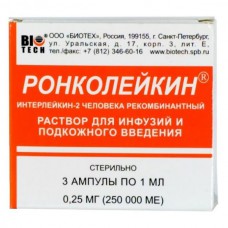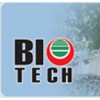Expiration date: 06/2026
The composition and form of issue:
Solution for intravenous and subcutaneous administration of 1 ml contains:
interleukin-2 human recombinant 0.1 mg (corresponding to 100000 IU)
0.25 mg (250000 IU fits)
0.5 mg (500000 IU fits)
1 mg (equivalent to 1 million IU)
excipients: sodium dodecyl sulphate (solubilizer) D-mannitol (stabilizer) dithiothreitol (reducing agent) ammonium carbonate acid water for injections
in 1 ml ampoules, complete with a knife ampulnam or scarifier, in a contour acheikova packing 3 or 5 ampoules in a cardboard pack 1 pack.
Description pharmaceutical form:
The drug is a clear, colorless or pale yellow liquid. When stored at temperature 2 to 8 °C, precipitation of crystals of sodium lauryl sulfate, which should dissolve at room temperature for 30 min To accelerate the dissolution can be tilted a vial, avoiding the sharp mixing of the liquid and foaming.
Feature:
The active component of the preparation of recombinant IL-2 (RIL-2) is a full structural and functional analogue of endogenous IL-2, isolated from cells of recombinant strain of the yeast Saccharomyces cerevisiae presents the restored form of the molecule.
Description pharmacological action:
IL-2 is produced by subpopulation of T-lymphocytes (T helper I) in response to antigenic stimulation. Synthesized IL-2 affects T cells, enhancing their proliferation and subsequent synthesis of IL-2.
The biological effects of IL-2 is mediated by its binding to specific receptors presented on various cellular targets.
IL-2 is directed affects the growth, differentiation and activation of T - and b-lymphocytes, monocytes, macrophages, oligodendroglialnah cells, Langerhans cells. From his presence depends on the development of cytolytic activity of natural killers and cytotoxic T-lymphocytes. IL-2 generates lymphokine-activated killer cells and activates puhelinpalvelussa cells.
The expansion of the range of lysing action of effector cells leads to the elimination of a variety of pathogens, infected and malignant cells, which provides immune defense directed against tumor cells and pathogens of viral, bacterial and fungal infection.
Indications:
In the complex therapy in adults:
- conventional variable immunodeficiency
- combined immunodeficiency
- acute peritonitis
- acute pancreatitis
- osteomyelitis
- endometritis
- severe pneumonia
- sepsis
- puerperal sepsis
- pulmonary tuberculosis
- generalized and severe localized infection
- infected burns and corrosions
- disseminated and locally advanced forms pochernkletocny cancer.
In children from birth:
- conventional variable immunodeficiency
- combined immunodeficiency
- acute peritonitis
- acute pancreatitis
- osteomyelitis
- severe pneumonia
- bacterial sepsis of newborn
- sepsis
- generalized and severe localized infection.
Contraindications:
- increased sensitivity to IL-2 or any component of the preparation in anamnesis
- Allergy to yeast
- pregnancy
- autoimmune diseases
- heart failure of III degree
- pulmonary-cardiac insufficiency of III degree
- metastatic brain lesions
- end-stage pochernkletocny cancer.
Caution: chronic renal failure, decompensated liver failure.
Side effects:
In some cases, the process of the introduction of Roncoleukin possible occurrence of intermittent chills and fever that stopped by the ordinary therapeutic means and is not grounds for the interruption of drug administration and treatment.
When s/to the introduction of a possible local reactions — pain, induration, redness at the injection site.
Drug interactions:
Treatment with Roncoleukin can be combined with treatment with all other drugs. In the application of Roncoleukin on the background of long-term therapy drugs glucocorticoid activity of the drug may be reduced. Roncoleukin do not mix with other drugs in the same syringe or vial.
Method of application and dose:
P/K or in/in, drip. 1 times per day 0.5–1 mg at intervals of 1-3 days, a course of 1-3 injections. For in/with the introduction of the drug from the ampoule is transferred into 400 ml of isotonic sodium chloride solution for injection. Infusion of the total volume of the solution is drip for 4-6 h. the drug Solution should be clear, colorless and does not contain extraneous inclusions.
Immunotherapy with Roncoleukin performed after completion of emergency interventions aimed at addressing the life-threatening consequences of the underlying disease/injury, rehabilitation and adequate drainage of the infectious focus.
In the treatment of severe sepsis conducted from 1 to 3 courses of treatment with Roncoleukin. The course includes 2 in/in infusion at a dose of 0.5 mg a day. The criterion for the assignment of second and third year is the continuing Roncoleukin in the treatment of lymphopenia (absolute or relative).
When for the first time revealed infiltrative destructive pulmonary tuberculosis — 3 in/in infusion of Roncoleukin at a dose of 0.5 mg every 48 h on the background of specific chemotherapy.
For preoperative preparation with progressing fibrous-cavernous tuberculosis (Fkt) of the lungs on the background of specific polychemotherapy:
- when unilateral Fkt — 3/the introduction of Roncoleukin 1 mg every 48 h
- in advanced Fkt lungs with bilateral focal dissemination — 7 in/in the introduction Roncoleukin: 3 introduction during the 1st week on 1 mg every 48 h, then 1 mg 2 times a week for 2 weeks. The recommended course of immunotherapy should be completed 7-10 days prior to surgery.
The purpose Roncoleukin in pulmonary tuberculosis is not expedient in the deficit of body weight more than 30%.
Treatment Roncoleukin of disseminated and locally advanced forms pochernkletocny cancer include:
- single s/C or/in the introduction of the drug in a dose of 0.5 mg for 24 hours before surgery
- in the 8-week course of immune chemotherapy 2 mg/every other day for the first 4 weeks of treatment. Repeated courses after 1-2 months.
Children Roncoleukin used in/in the drip. Patterns of use correspond to those in adults. The drug is diluted in isotonic 0.9% sodium chloride solution for injection. Single dose and the volume of isotonic solution in children depends on age:
- from birth to 1 month — 0.1 mg in 30-50 ml of solution
- from 1 month to 1 year — 0.125 mg in 100 ml solution
- from 1 year to 7 years — 0.25 mg per 200 ml solution
- over 7 years — 0.5 mg in 200 ml
- over 14 years — 0.5 mg in 400 ml of solution.
Overdose:
Symptoms were observed at a dose of Roncoleukin above 7 mg in the form of fever, arrhythmias, hypotension, allergic skin reactions.
Treatment: these side effects disappear after drug withdrawal, if necessary, symptomatic therapy.
Special instructions:
Effects on ability to drive or to perform work requiring high speed physical and mental reactions. Special studies of the effect of the drug on the ability to drive vehicles and use sophisticated equipment was carried out. In the case of development of undesirable reactions of the organ of vision and/or reduced ability to concentrate and responsiveness to patients are advised to refrain from driving vehicles or operating complex equipment pending the resolution of these adverse reactions.
Storage conditions:
It is allowed to transport at a temperature of from 9-25 °C for 10 days.



